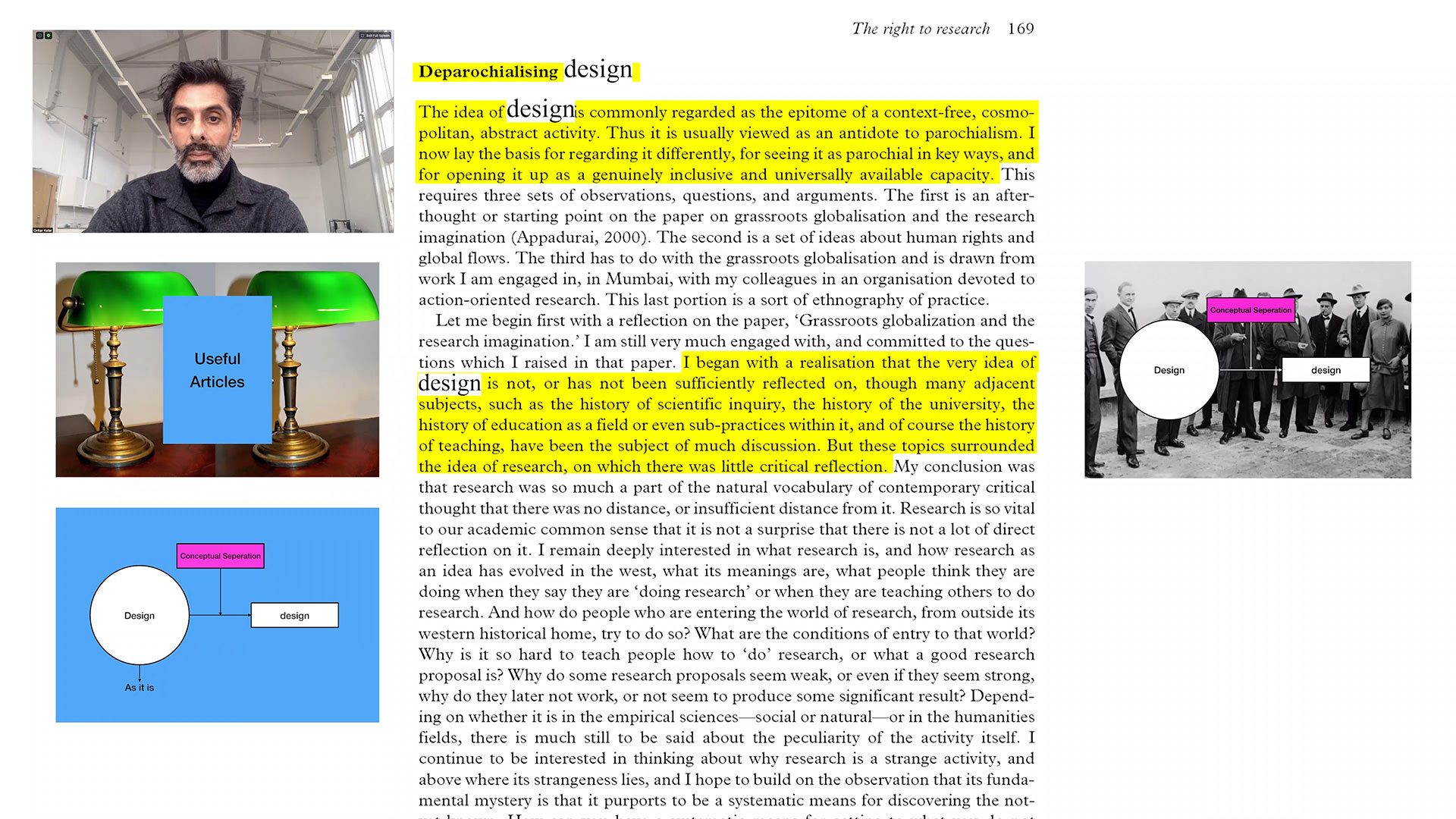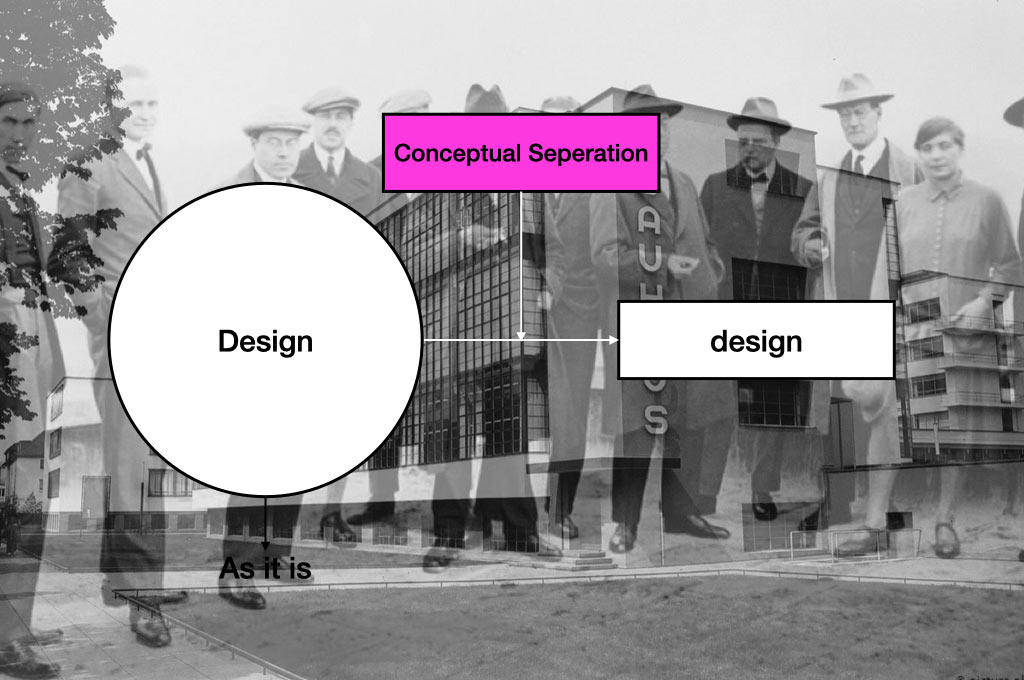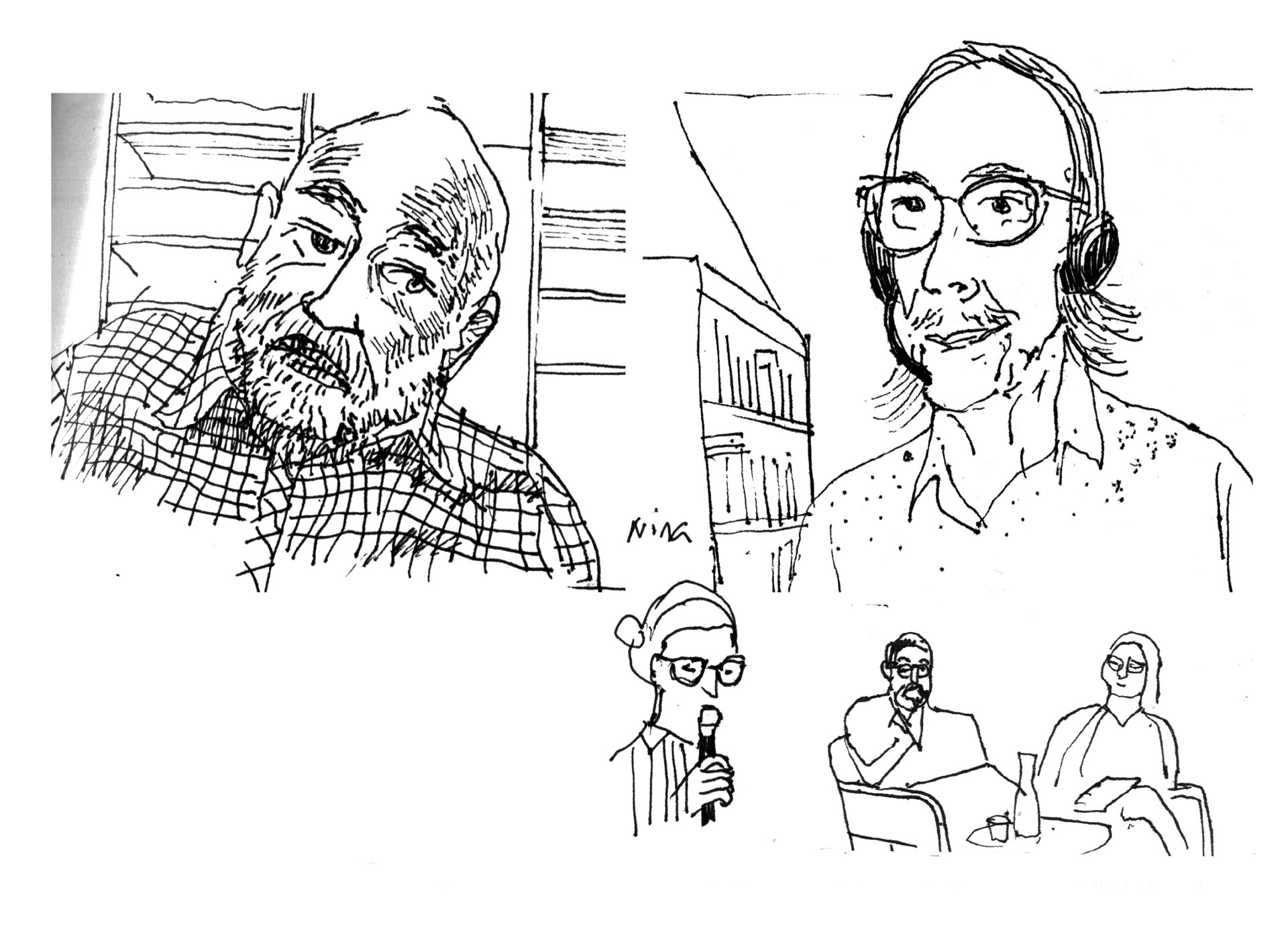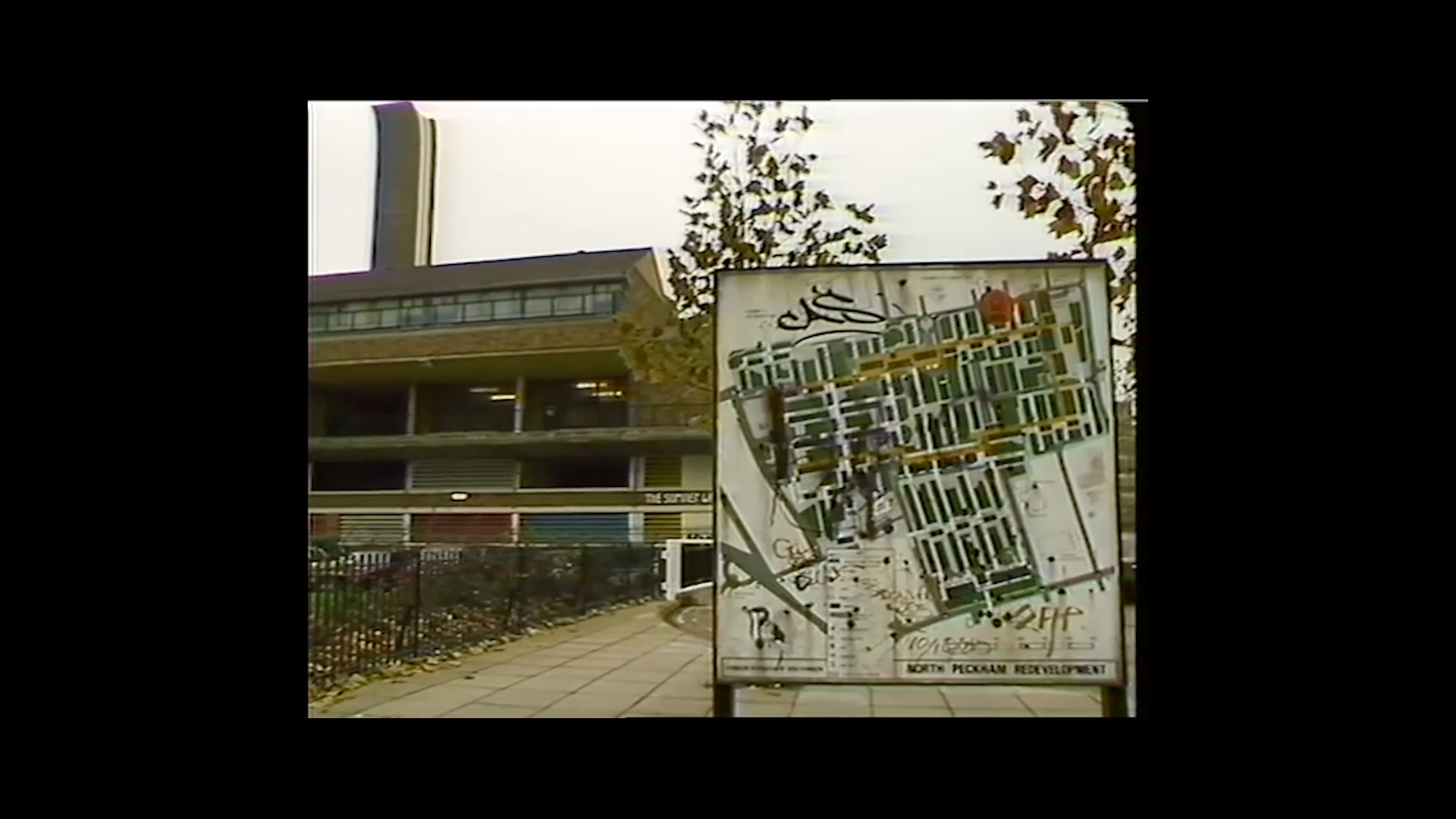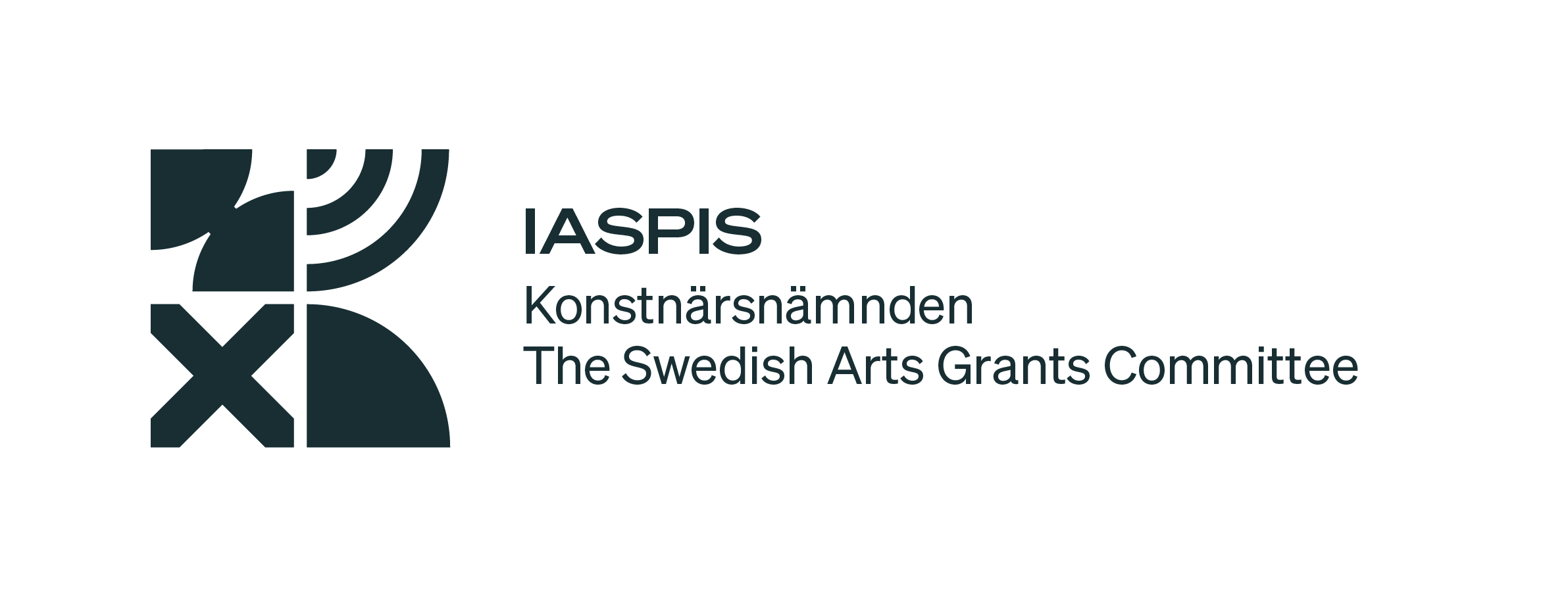Issue #9
The Right to design
Onkar Kular and Henric Benesch (Eds.), Arjun Appadurai, Arturo Escobar, Caleb Femi
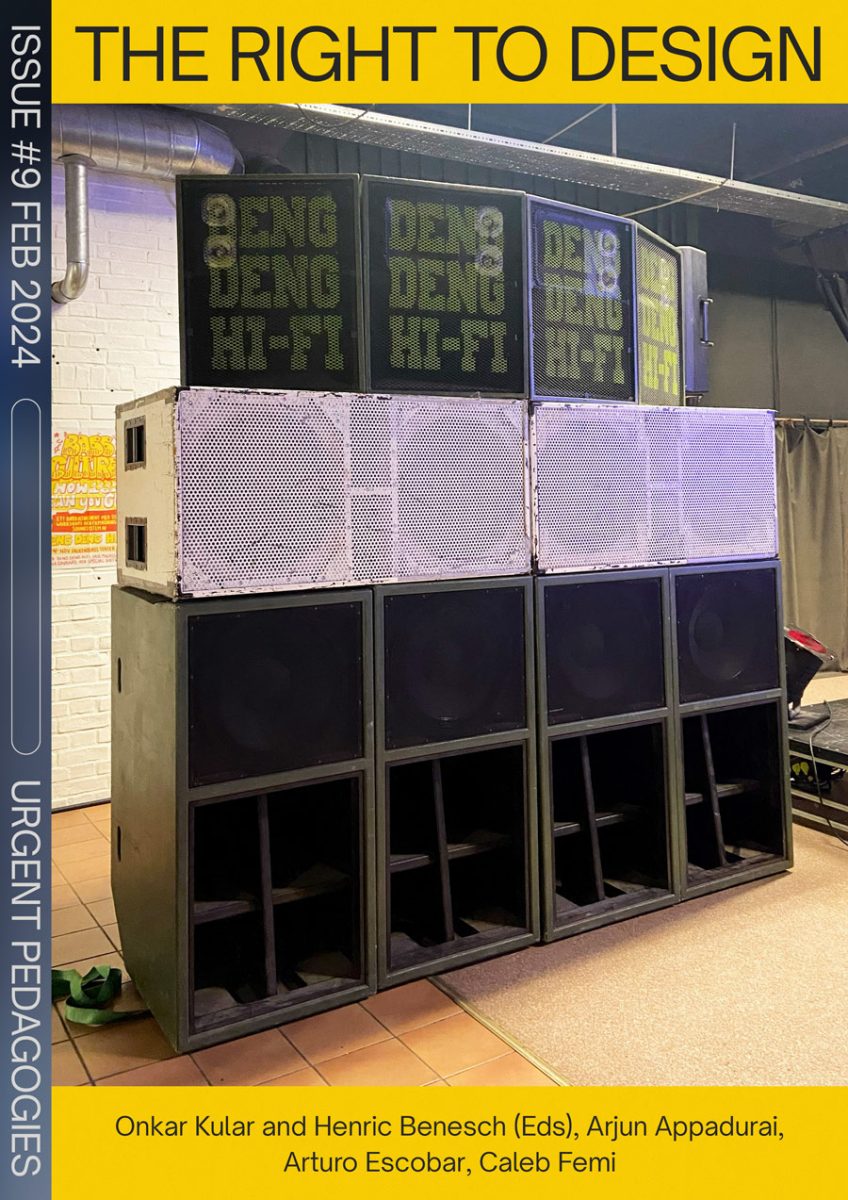
CATEGORY
Welcome to Issue 9: The Right to design, guest edited by Onkar Kular and Henric Benesch. The Right to design is a practice-based platform that examines the historic and contemporary relationship between design and rights.
The following is an interview with Onkar Kular and Henric Benesch outlining the genealogy of The Right to design platform, design education today, and an introduction to the contributions of Issue #9. Questions by Magnus Ericson.
Magnus Ericson: I understand The Right to design platform aims to question, discuss and rethink design education—and perhaps design as a discipline itself—through critically addressing its inability to focus on our ongoing political and environmental crisis.
You suggest that the designer, by being trapped within its disciplinary frameworks, perhaps is “getting in the way of design.” You point towards these frameworks as upholding design as “the privilege of the few” rather than “the right of many.” Can you describe this point of departure and the obstructing frameworks? Can you perhaps give some examples where Design (with a capital D) is failing?
Onkar Kular/Henric Benesch: In a way, our point of departure is a recognition that the word “design” and, more so, the notion of the “designer” is a historically and geographically situated concept which, as part of “first world” schemes projected and broadcasted in the past centuries, has colonised our ways of understanding, making cultures, and making processes on a global scale. Why is it that some things are considered to be designed, and some things are merely things? What purpose does such distinction serve? We also recognise that we have started to ask these questions in relation to the very particular geographies we operate within and from. Asking such questions in a Swedish or British context, which we know best, is quite different from asking such a question, for instance, in an Indian or Colombian context.
And while the answer to these questions indeed has to do with cultures, economies, and politics in a broad sense, the first and foremost regulatory framework for actualising these distinctions and relations, for example, through education, is the nation-state. So one thing we have come to realise is that though we indeed need to ask such questions across these geographies, there is always a level of taken-for-grantedness where the notion of design and the designer (within a shared language) on the one hand enables such conversations, but also on the other hand, tends to move structural and cultural differences out of the picture.
But to give an example from our point of departure. In Sweden, all higher education is free for Swedish nationals, and the state offers subsidised student loans to give everyone an equal opportunity to access higher education. There is, of course, a long history here, but when it comes to design, the actual educational pathway often includes years of post-compulsory studies, also eligible for student loans. So getting a bachelor’s in design could take 5 or 6 years and in combination with a master’s 7 or 8 years. You need to be willing and able to invest 8 years of your life and carry an accumulated loan throughout most of your professional career to get a job, which, to be frank, is not that well-paid compared to other career paths of equal length and investment.
Additionally, the social capital that enables you to even consider taking such a career path is the social capital that, in many cases, carries your future career. Since such a system has been at play for at least the past 40 years or so, it is clear that design, as constituted through these educational and professional mechanisms, is populated by some social groups more than others. And while this is a problem in itself, it becomes particularly problematic in relation to how design positions itself as the custodian of the things that support our lifeworlds at large.
So, bluntly put, there is a very particular social imaginary at play here, cultivated by a few but pertaining to many, which, together with the structural mechanism described, produces a self-regulatory and solipsistic system separating the mere things (design) from the things which in particular are signifiers of values within those social imaginaries (Design).
Magnus Ericson: Is it that design education is stuck and occupied with reproducing an established (and Western) idea of what design is and that it has lost its relation to a complex contemporary reality?
Onkar Kular/Henric Benesch: Again, there is a need to be mindful of where one is speaking from and what one is speaking about. But yes, design education, at least in Scandinavia and UK contexts, struggles with and has a challenge in dealing with the way it is structured around an “established (and Western) idea of what design is.” And again, returning to the first question—what is identified as “complex contemporary realities”? It is not that design education is not trying to engage in the world’s complexities, in doing ‘good,’ but it often does so from a very circumscribed and limited vantage point. Again, it has more relations to some complex contemporary realities than others. One might even say that complex realities to which there is a relation form a legacy in themselves as these relations are often passed down from teachers to students without reflection. But again, what complex realities are brought to the table? Should it be the realities cultivated by the teachers or should it be the complex realities from which a future generation of designers spring?
ME: In the text that you have authored for this issue, you refer to Clive Dilnot who suggests that design may be better without designers and that new forms of design education may have to look elsewhere for ideas. It seems not only a question about how to but also where from one can learn. Can you elaborate a little on this and also perhaps through some examples?
Onkar Kular/Henric Benesch: There are, of course, different designers but what we want to pick up on here is the professional designer as the first and foremost subject-position cultivated through educational frameworks. A subject-position particularly strong, at least in our current context. We are not against this subject-position, but we see that, as suggested by Clive Dilnot, it gets in the way of other subject-positions, where designerly skills and knowledge are less foregrounded but equally valuable, both in professional and everyday perspectives. So, with the risk of being a bit rhetoric, this is already happening in basic education, vocational programs, youth clubs, study circles, and within informal learning settings, but not under the guise of design education and not as a subject in its own right.
For instance, the production, distribution and consummation of “things” in relation to sustainability and social justice are topics which not only are discussed at design schools, but they are something that we come across and are faced with at a very young age, even within the first years of basic education. Additionally, skills such as drawing and crafting are also something most children in some shape or form engage with at a very young age. And even as an adult you can take up classes in these subjects at different study associations. Of course one can have a discussion of what one means with design (or not), but the point here is not so much what counts as design or not, but there are indeed quite a lot of training frameworks where you engage with the making of things and the implications of the making of things from various perspectives. As you mention, we have elaborated on some of these points in The Right to design text that we first authored in 2021 and included in this issue.
Magnus Ericson: You mention the idea of “un-discipline” design and suggest the “right to design” through a parallel to Arjun Appadurai’s concept “the right to research” and the idea of design as a kind of “readership.” Can you explain this a little and how this may change the idea of design itself?
Onkar Kular/Henric Benesch: Again, we have argued that design, as cultivated amongst professional designers and within design education, is centred around an authorship model—the designer creating responses to the shortcomings of the lifeworlds which the designer interacts with. In our perspective, the combination of this particular subject-position and a particular vocational position—that of a professional, overshadows other positions where you also engage with design—but not with the purpose of being a designer and/or making a living as a professional designer. Here we can add that the everyday autonomous acts of designing by individuals or groups have not been given significant attention as they also do not conform to the authorship model.
To draw a parallel, the need to decipher, filter, and understand the constant flow of hypermediated information has prompted a broader discussion on media literacy as an important component for exercising world citizenship today. Similarly, the need to be able to make informed choices regarding how we use and relate to designed things, material and virtual, produced, distributed and used across geographies, necessitates a broader discussion on what could be described as “design literacy.” Or put differently, perceiving the “producer” position as the active and critical position serves the established professional designer-position well. But what if an equally active and critical “consumer” position were equally foregrounded and problematised and not only amongst designers?
With that said, part of the argument is that it is already happening, but not within design education frameworks, in turn prompting the questions of the where, how and whom of design education.
Magnus Ericson: You suggest that designing is something that should be opened up and not only be a concern for designers, and that this readership has to acknowledge, respect and support different perspectives. One perspective that you have outlined is to engage more broadly with the role of governmental policies and proposed a concept of 1% rule for Public Design. Can you briefly explain the idea and what it may open up for—and how this could contribute to changing and developing design education?
Onkar Kular/Henric Benesch: First, with this proposal, we want to also emphasise the importance of engaging critically and actively with policies and governmental structures that directly and indirectly shape the conditions for design and designing. In Sweden, there already exists a 1% role for public art—stating that at least one percent of the budget, when building, refurbishing and/or extending properties, infrastructure and public environments, must be invested in building-related art. This rule exercised nationally and in parts on a regional level, was originally implemented in 1937. Notwithstanding its issues, this rule has not only created work opportunities for artists but also cultivated a broader perception of public art as integral in our living environment.
The concept of 1% rule for Public Design was proposed in relation to Sweden’s 2017 Gestaltad Livsmiljö or Policy for Designed Living Environment where we outlined that structural changes are necessary—both with regard to the planning of our design living environment and the educational support structures surrounding these processes. As an example, one key phrase the policy repeats a number of times is that “architecture and design will help to create a sustainable, equitable and less segregated society with carefully designed living environments in which everyone is well placed to influence the development of their shared environment.” Taking this statement at face value and assuming that this new policy wants to make a difference, we see that new ways to operationalise this ambition must be developed and resourced. As a speculative exercise we have outlined this in more detail as part of the text, “What if a 1%-rule for Public Design” for AIO (Art-Inside-Out) Journal, taking cues from public service frameworks such as jury service, we speculated on how a Public Design Office—staffed by citizens and professionals together—combined with a Public Design Wage and a Public Design Education—as part of compulsory education, financed through such a 1%-rule—could be developed in direct response to aim of the policy. Broadly speaking, we see that other forms of design education can engage throughout more sectors of society, besides its current position at the top of the pyramid only accessible to a few.
Magnus Ericson: Through The Right to design as a platform you have developed a number of activities over time, such as assemblies, misreadings and other educational initiatives. As a way of introducing the contributions of this issue, can you tell me about these and what they have resulted in?
Onkar Kular/Henric Benesch: The Right to design platform has its origin in the idea of misreading of Arjun Appadurai’s 2006 paper, “The Right to Research, Globalisation, Societies and Education” where we reworked and elaborated on the original text as a consequence of replacing “research” with “design.” We developed the misreading into a mixed media presentation for the PARSE Conference, Human in 2019 and subsequently translated this misreading into a recorded paper, A Purposeful Misreading included in this issue.
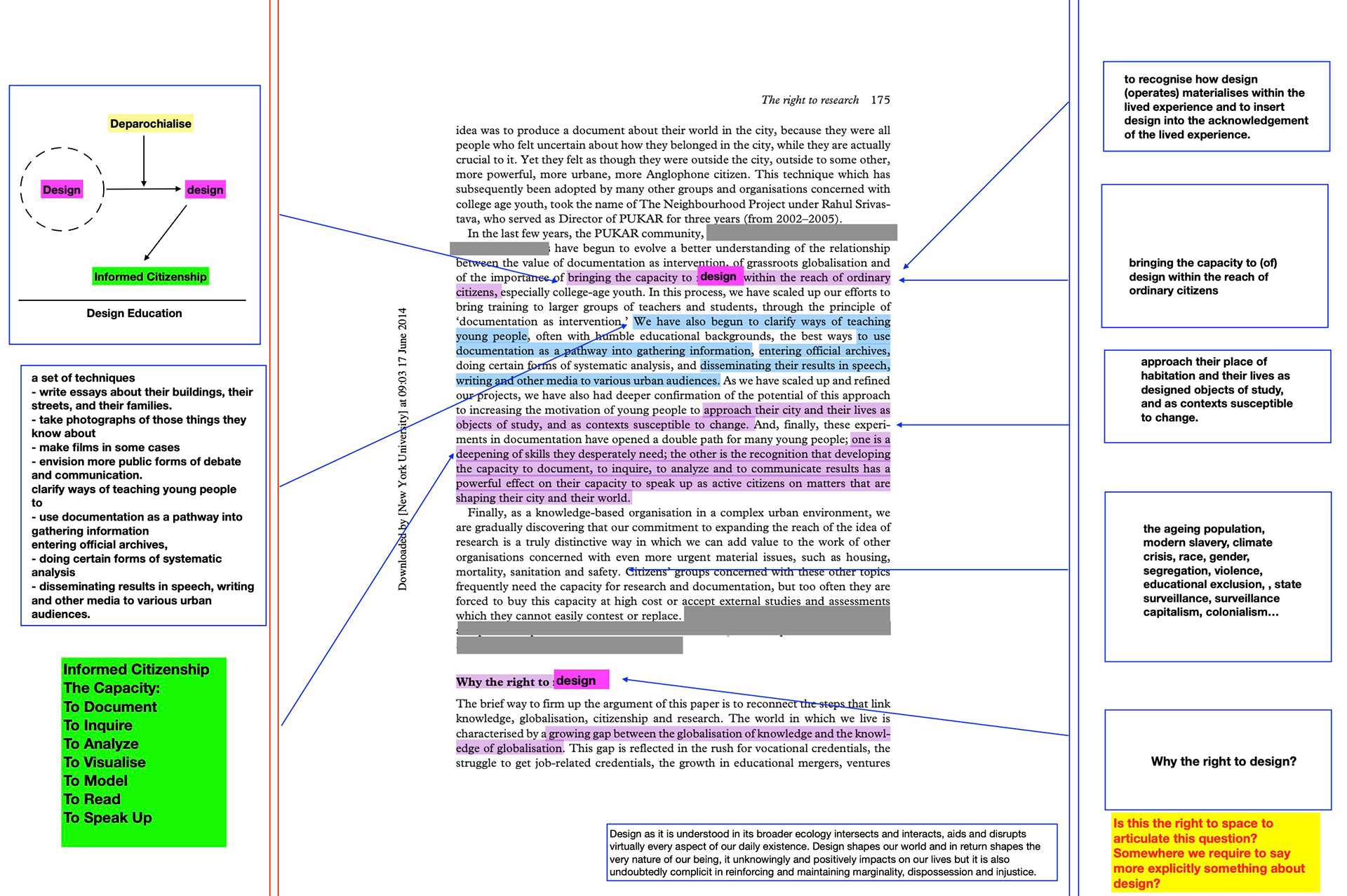
Image from A Purposeful Misreading Script, PARSE Journal 12, Human, 2020.
Since then we have been practising collective and close misreadings by making use of a range of texts—from poetry, essays and policy documents that generally sit outside of the more conventional design writing you might find in design books, blogs and journals. As such, the texts that we collectively work with do not address design directly but where design is integral in different lifeworlds—basically reading design through lenses other than design (as custom within professional practice and design education). We have found that such collective misreading is a way of shifting away from professional expectations and design frameworks and generating a shared discussion across generations, places and proficiencies, anchored in lifeworlds rather than an academic subject.
To some degree, misreading as practice and method is a more concrete actualisation of our thoughts on readership outlined earlier. These two ideas, design readership and misreading, could perhaps even be considered two sides of the same coin. And one way of telling this story is how it started, namely the “purposeful misreading” of “The Right to Research, Globalisation, Societies and Education.” In reality it was a simplistic and somewhat speculative idea, asking the question of what would happen if we replaced the word “research” with the word “design” within Appadurai’s original text. Our idea was that Appadurai’s argument for the “right” to “research” was equally relevant in the context of “design” in terms of “right” to “design.” The change of words was a way to test this idea, to see how Appadurai’s structural analysis made sense in a design context. The simple task was to replace the words, and the real task was to rethink the notion of design and design education in the light of Appadurai’s overall arguments and structuring of the question. How would the arguments translate into a design context and what were the contexts (of design) where these arguments could be said to be pertinent. This was much more work than we anticipated, but in the end we were able to outline some of the arguments you find throughout the work we have been producing through the platform.
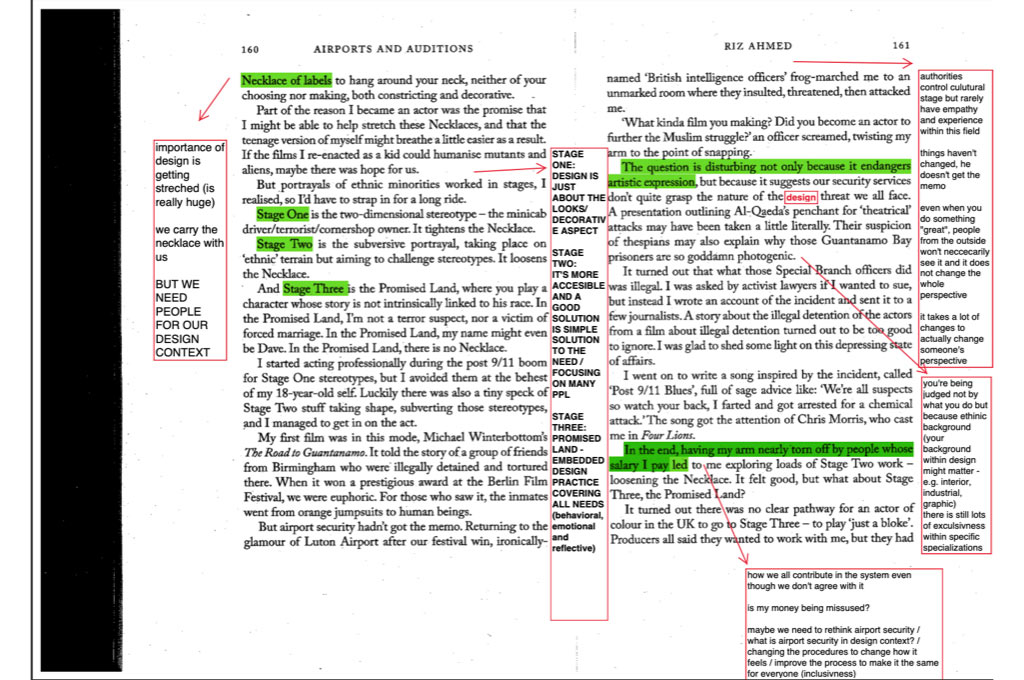
MA Design Student Misreading of Airports and Auditions Essay by Rapper, Actor and Director Riz Ahmed (2022)
We have since been misreading a number of texts together with students and others as if they are texts about design, ranging from poetry to policies, to get a sense of design from non-design-perspectives, engaging in acts of translation. So for us, misreading has been a device to escape or undo some of the disciplinary demarcations which we think hampers “design.” Engaging with “other” texts allows the possibility to engage with a broader group of people, experiences and ideas than would be possible with more conventional design related texts. More so, they allow you to enter into discussion of design in ways which are not dominated by design-perspective as such. Here, at best, design really becomes an integral part of lifeworlds, devoid of various interpretative prerogatives as far as possible.
And here we would like to stress that what we consider a misreading is not merely a misreading, any random interpretation or translation, but a purposeful one, aiming at unpacking new ways of understanding subject matters and their interpretation in shared contexts. It can be considered an investigation as well as interrogation (as with the case of The Right to design), by proposing an interpretation in advance and unpacking it afterwards. In this sense, the misreading can be considered a speculative methodology, a “what if,” but rather than speculating on how design possibly can operate in the world, the purpose here is to understand how design already operates within the world.
As the practice of misreading has developed it has allowed us to expand the ideas of the platform by inviting and collaborating with other practitioners and organisations. Following a misreading between MA design students from Birmingham City University, University of Gothenburg and the poet and director Caleb Femi, in 2022 Caleb was invited to Göteborgs Litteraturhus to take part in a public reading and conversation around his widely acclaimed publication Poor. As part of the event, we extended the idea of the misreading into a study and reading circle through an open call to spoken-word and poetry groups in Gothenburg. The recording from the event, Too many public futures are decided in private rooms is included in this issue.
We are also mindful that The Right to design as a frame and a proposition is something which extends far beyond our expertise, seeing a necessity in exploring, mapping, and practising ‘right to design’ together with others. But also embracing curiosity as a modality, which for various reasons, at least within academia, somehow tends to be overshadowed by other modalities of inquiry—such as expertise. In 2021, we organised the public mapping Another possible is possible at the Röhsska Museum, Gothenburg.
The public mapping was organised through the frames of The Design of Rights, which considered the history of rights as designed artefacts with complex histories and politics. Design Rights Now foregrounds the existing relationship between design and rights such as Intellectual Property Laws (copyright, trademarks and patents). Design Rights Violations outlines design practices that visualise, materialise and mediate rights violations and injustices. Design Literacy and Readership works as a means to show how design itself can be the tool for producing and facilitating rights violations and injustices. And The Right not be designed considers how development projects as well as computational systems intentionally design subjects and subjectivities. The final frame was prompted and further discussed in a conversation between anthropologists Arjun Appadurai and Arturo Escobar included here, Another Possible is Possible: The Right not to be designed, as part of the issue. Additional transcriptions from the mapping can be found at the research publishing platform PARSE where we have been supported in developing and archiving the activities of the platform.
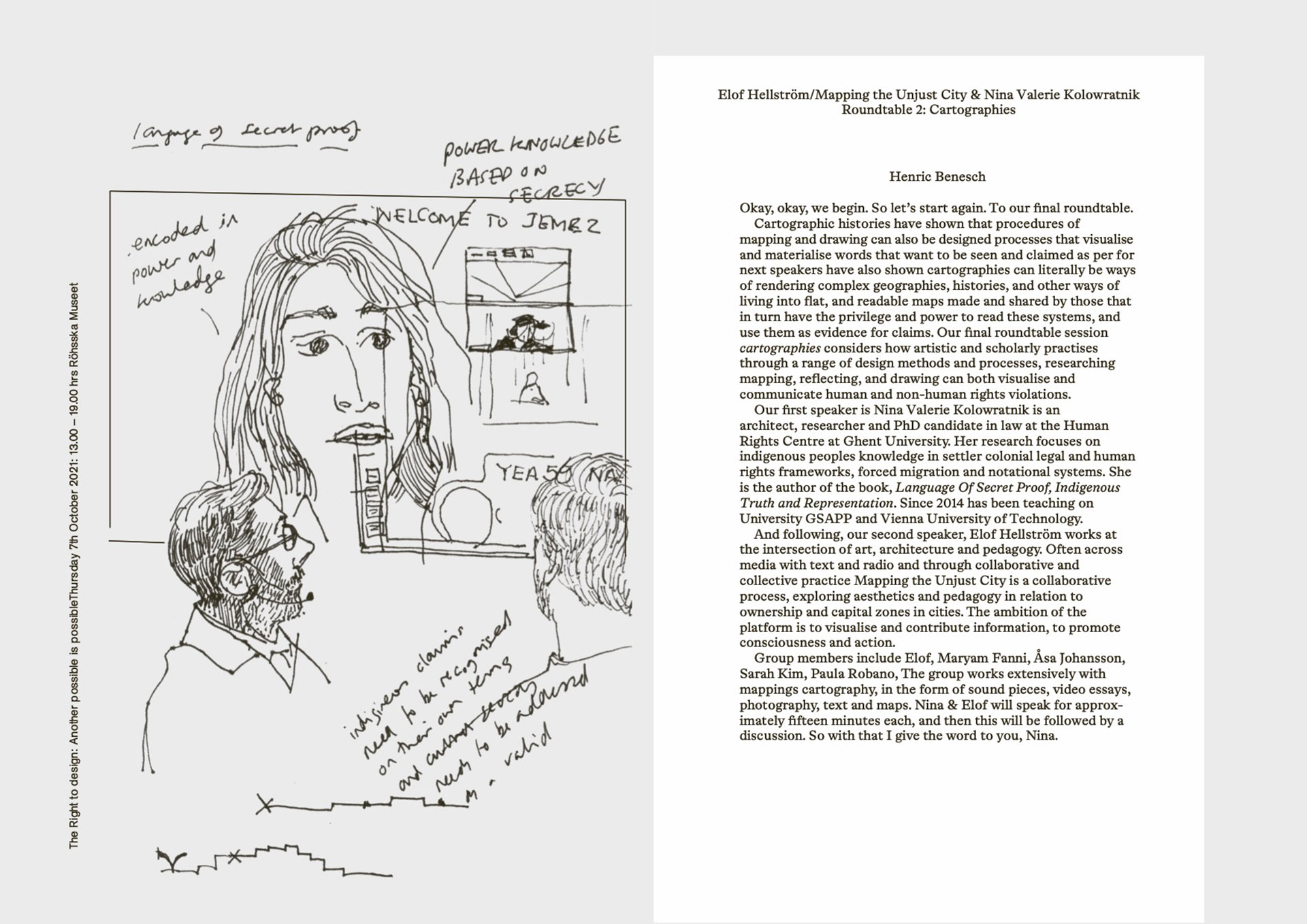
Another Possible is Possible: The Language of Secret Proof, Röhsska Museum. Event Sketch and Transcription by Åbäke, 2021
Subsequently and as a development of the What if a 1%-rule for Public Design text, during 2023 we were invited to participate in the Art Inside Out, Falkenberg residency programme. Through the residency we were keen to further develop and expand the practice of the platform by considering whether the right to design can also be a means to investigate and re-narrate design histories. And parallel to misreading texts, to see whether there is a possibility of misreading design into histories or historical moments. Here we were interested in how bass music such as reggae, dub, techno, jungle, and grime have produced material cultures through autonomous modes of designing and making that have been largely ignored by mainstream architecture and design history and education. As a culmination of the residency, we organised a two day sonic festival with Bass Cultures, How Low Can You Go! at Falkenbergs Teater that brought together musicians, makers, and listeners that have played an important role in bass culture in Sweden. The final contribution within this issue, A Public Design Broadcast outlines the festival programme of screenings, workshops, talks, and DJ sets with additional framing texts situating bass cultures and sound systems as sites for autonomous designing, learning, and pedagogy.
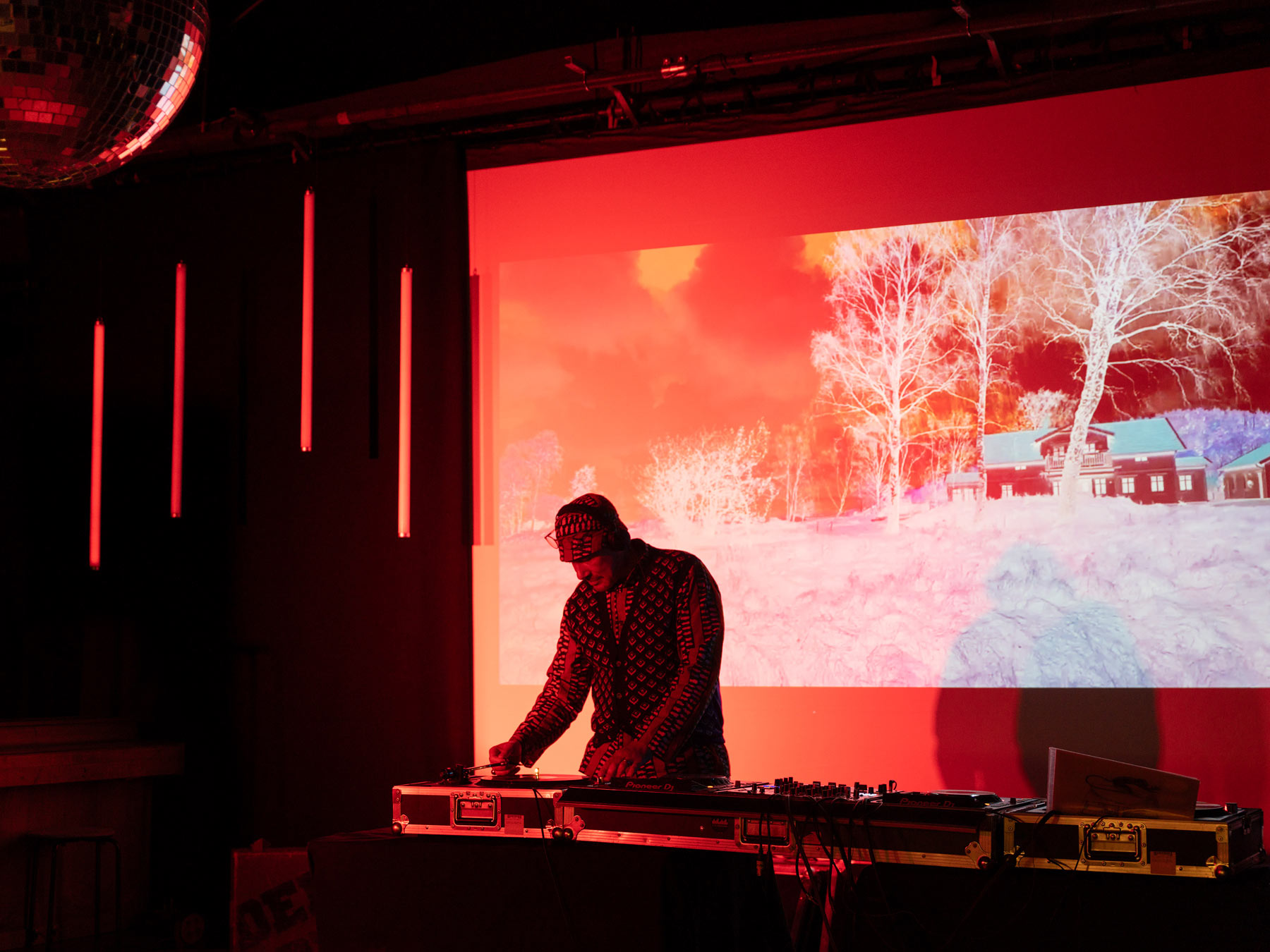
Eric Magassa, Sonic Essay. Bass Culture: How Low Can You Go!, Falkenbergs Teater 2023, Photo: Joel Nilsson
Contents
A Purposeful Misreading
Onkar Kular and Henric Benesch
The Right to design
Onkar Kular and Henric Benesch
Another Possible is Possible: The Right not to be designed
Arjun Appadurai and Arturo Escobar in conversation
Too many public futures are decided in private rooms
Caleb Femi in conversation with Onkar Kular
A Public Design Broadcast
Bass Cultures, How Low Can You!
is a practice-based research platform run by Onkar Kular and Henric Benesch. The platform has the dual aim of understanding the entangled historic and present relationship between design and rights and to claim ‘design’ itself as a special kind of right that is accessible beyond class background, gender, ethnicity, age, and disability. The platform currently serves as the base for activities such as assemblies, (mis)readings, broadcasting and educational initiatives with partners inside and outside academia.
is Professor of Design at HDK Valand, Academy of Art & Design and Programme coordinator for PLACE (Public Life, Arts, Critical Engagement) at the Artistic Faculty, University of Gothenburg. His research is disseminated internationally through commissions, exhibitions, education, and publications. His work is in the collection of the CNAP, France, and Crafts Council, UK. He has guest-curated exhibitions for The Citizens Archive of Pakistan, Karachi, and the Crafts Council, UK. He was Stanley Picker Fellow 2016 and Artistic Director of Gothenburg Design Festival, Open Week 2017 and Co-Artistic Director of Luleå Art Biennial 2022.
is an associate professor (docent) in Design at HDK-Valand—Academy of Art and Design—acting Dean at The Artistic Faculty and an associate of Centre for Critical Heritage Studies (CCHS) at the University of Gothenburg. He is an architect interested in socio-material, spatial, and temporal aspects of knowledge regimes and (co-)creation of knowledge with a particular interest in situated and speculative methodologies. During 2023, together with Onkar Kular, he participated in “The Public Design Office”, an ArtInsideOut Residency in Falkenberg (SE). Recent publications include “The Right to design” (2020), “What if a 1%-rule for Public Design” (2021), and “Co-curating the city: universities and urban heritage past and future” (2022).
is Head of IASPIS Applied Arts Programme, responsible for the design, crafts and architecture related activities. He has a background as curator, project coordinator and educator working across design, architecture, urbanism and art. Between 2014 and 2018 he developed and managed two experimental postgraduate courses on socially engaged critical practice; Sites and Situations and Organising Discourse, at Konstfack University College of Arts, Crafts and Design, Stockholm. Between 2009 and 2014 Magnus Ericson was a Senior Advisor/Curator at Arkdes, Sweden´s National Center for Architecture and Design, in Stockholm. Together with Ramia Maze he was the author and co-editor of DESIGN ACT Socially and politically engaged design today – critical roles and emerging tactics (Berlin, Sternberg Press 2011). Together with Pelin Tan Magnus Ericson is the curator of Urgent Pedagogies.
is the Goddard Professor (Emeritus) in Media, Culture and Communication at New York University. He is also The Max Weber Global Professor at the Bard Graduate Center (New York). He is a Fellow of the American Academy of Arts and Sciences and is a Member of the UNESCO Commission on The Futures of Education. He is Co-Editor of Public Culture and serves on the Editorial Board of Global Perspectives. He has authored numerous books and scholarly articles, including Fear of Small Numbers: An Essay on the Geography of Anger (Duke 2006), Modernity at Large: Cultural Dimensions of Globalization, (Minnesota 1996; Oxford India 1997), The Future as a Cultural Fact: Essays on the Global Condition (Verso 2013), and Banking on Words: The Failure of Language in the Age of Derivative Finance (Chicago, 2016). His most recent book, co-authored with Neta Alexander, is Failure (Polity Press 2019). His books have been translated into French, German, Spanish, Portuguese, Japanese, Chinese and Italian. He is currently working on a study of the new political lives of caste in India.
is an activist-researcher from Cali, Colombia, working on territorial struggles against extractivism, post-developmentalist and post-capitalist transitions, and ontological design. He was professor of anthropology and political ecology at UNC, Chapel Hill, until 2018, and is currently affiliated with PhD Programs in Design and Creation (Universidad de Caldas, Manizales, Colombia) and in Environmental Sciences (Universidad del Valle, Cali). Over the past twenty-five years, he has worked closely with Afro-descendant, environmental and feminist organisations in Colombia. His most well-known book is Encountering Development: The Making and Unmaking of the Third World (1995, 2nd Ed. 2011). His most recent books are: Designs for the Pluriverse: Radical Interdependence, Autonomy, and the Making of Worlds (2018); Pluriversal Politics: The Real and the Possible (2020); and Designing Relationally: Making and Restor(y)ing Life, with Michal Osterweil and Kriti Sharma (forthcoming).
is a Poet and Director who grew up on North Peckham Estate in Southeast London. Working with film, photography and music, he pushes the boundaries of poetry and the written word on the page, in performance and in digital mediums. He has written and directed short films for the BBC and Channel 4 and poems for Tate Modern, The Royal Society for Literature, St Paul’s Cathedral and many other organisations. Between 2016 and 2018, Caleb was the Young People’s Laureate for London. As a recognition of his important and timely work, the writer has won the Forward Prize for Best First Collection (2021) with recent articles in the Guardian and London Review of Books.
